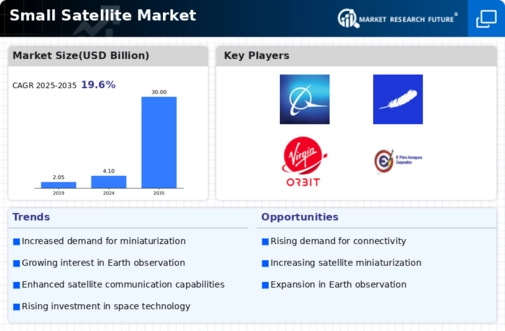Cost-Effectiveness of Small Satellites
The Small Satellite Market is significantly influenced by the cost-effectiveness of deploying small satellites compared to traditional larger satellites. The reduced manufacturing and launch costs associated with small satellites make them an attractive option for various applications, including scientific research, Earth observation, and telecommunications. Reports indicate that the average cost of launching a small satellite can be as low as 1 million USD, which is substantially lower than the costs associated with larger satellite systems. This affordability allows a broader range of organizations, including startups and academic institutions, to participate in space exploration and satellite deployment. As a result, the market is likely to witness an influx of new entrants, further driving innovation and competition within the Small Satellite Industry.
Emergence of New Business Models in Space
The Small Satellite Market is experiencing a transformation due to the emergence of new business models that leverage small satellite technology. Companies are increasingly adopting innovative approaches, such as satellite-as-a-service and data-as-a-service, to meet the diverse needs of clients. This shift is enabling organizations to access satellite capabilities without the need for significant upfront investments. The market is projected to see a substantial increase in revenue from these new business models, with estimates suggesting a growth rate of over 15 percent annually. This trend is likely to attract a wider range of stakeholders, including private enterprises and government agencies, fostering collaboration and driving further advancements in the Small Satellite Industry.
Growing Demand for Communication Services
The Small Satellite Market is experiencing a notable surge in demand for communication services. As the need for reliable and high-speed connectivity increases, small satellites are becoming essential for providing broadband services, especially in remote areas. The market for satellite communication is projected to reach approximately 100 billion USD by 2025, indicating a robust growth trajectory. This demand is driven by the increasing reliance on satellite technology for internet access, particularly in underserved regions. Furthermore, advancements in satellite technology are enabling more efficient data transmission, which is likely to enhance the overall service quality. Consequently, the proliferation of small satellites is expected to play a pivotal role in meeting the growing communication needs of various sectors, including telecommunications, media, and government services.
Technological Advancements in Satellite Design
The Small Satellite Industry is benefiting from rapid technological advancements in satellite design and manufacturing. Innovations such as 3D printing and modular satellite architectures are enabling faster production times and more flexible designs. These advancements allow for the integration of advanced sensors and payloads, enhancing the capabilities of small satellites. For instance, the development of CubeSats has revolutionized the market by providing a standardized platform for various missions. The increasing sophistication of small satellites is expected to attract investments, with the market projected to grow at a compound annual growth rate of over 20 percent in the coming years. This trend indicates a strong potential for small satellites to fulfill diverse mission requirements across different sectors.
Rising Interest in Earth Observation Applications
The Small Satellite Industry is witnessing a rising interest in Earth observation applications, driven by the need for real-time data for environmental monitoring, agriculture, and disaster management. Small satellites are particularly well-suited for these applications due to their ability to provide high-resolution imagery at a lower cost. The market for Earth observation satellites is expected to reach approximately 5 billion USD by 2025, reflecting the increasing demand for satellite-based data analytics. This trend is further supported by government initiatives aimed at enhancing satellite capabilities for monitoring climate change and natural disasters. As a result, small satellites are likely to play a crucial role in providing timely and accurate information to support decision-making processes in various sectors.


















Leave a Comment